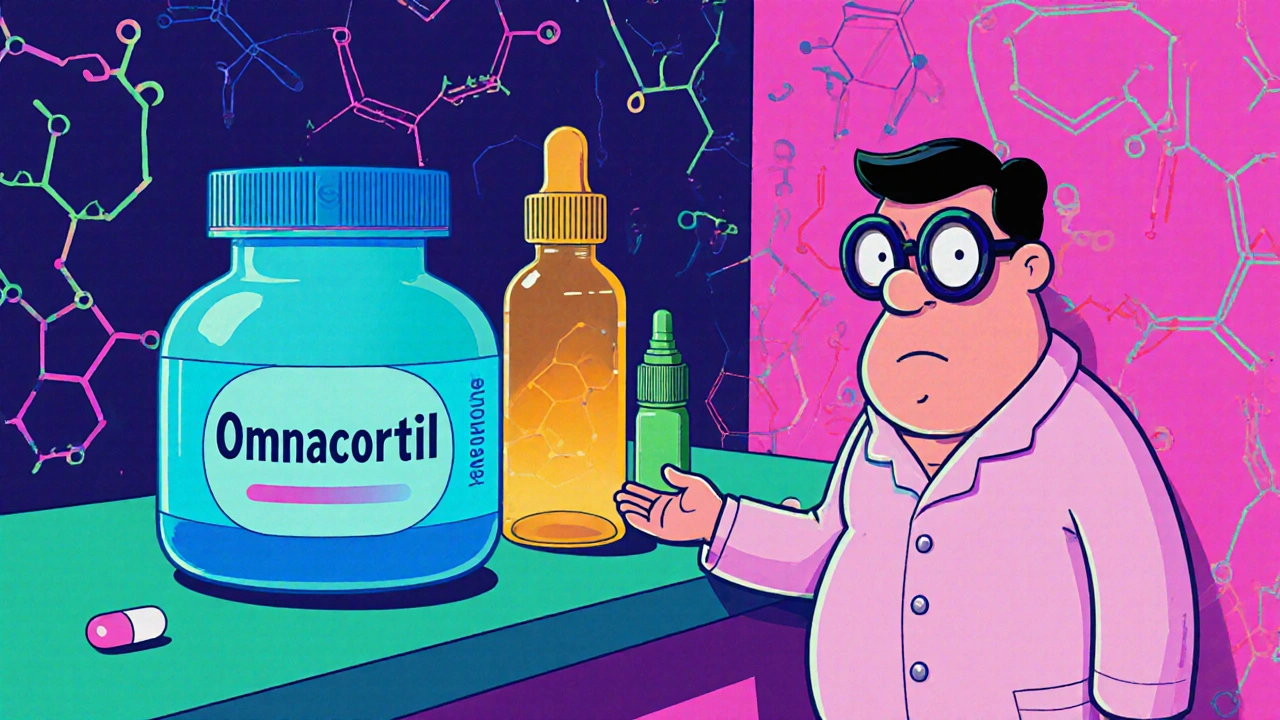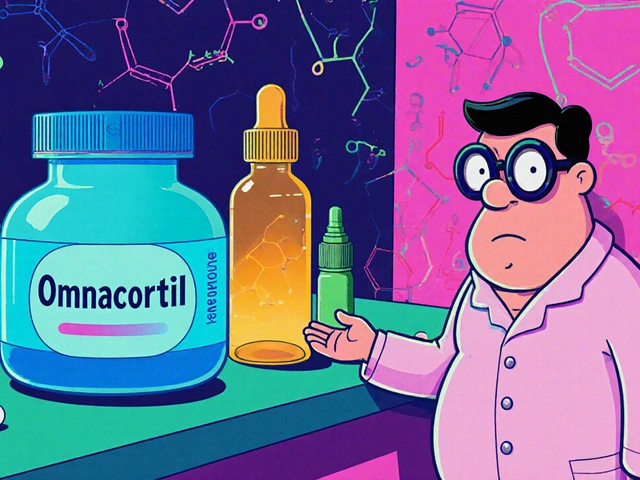Steroid Dose Converter
Convert Between Steroid Doses
Enter a dose in one steroid and see the equivalent dose in another steroid using standardized potency ratios.
Note: This calculator uses average potency ratios. Always consult with your healthcare provider before adjusting your steroid regimen.
If you’re weighing Omnacortil against other steroid options, you’ve probably asked yourself: how does this drug really stack up in terms of potency, safety, and everyday use? The short answer is that Omnacortil (prednisolone) is a middle‑strength glucocorticoid, but the nuances matter when you consider side‑effects, dosing schedules, and the specific condition you’re treating.
When doctors prescribe a steroid for inflammation, Omnacortil (Prednisolone) is a synthetic glucocorticoid that mimics cortisol’s anti‑inflammatory actions. It was first marketed in the 1960s and has become a workhorse for allergic reactions, autoimmune disorders, and certain cancers. Understanding its profile helps you decide whether a different steroid might be a better fit.
What Sets Omnacortil Apart?
Omnacortil’s key attributes are its oral bioavailability, moderate potency, and relatively short half‑life (about 3‑4 hours). These traits make it easy to taper, which is crucial for chronic conditions where long‑term steroid exposure is a concern.
- Potency: Roughly 4‑5 times more potent than cortisol.
- Onset: Effects begin within 1‑2 hours of ingestion.
- Typical dose range: 5‑60 mg per day, split into once‑ or twice‑daily dosing.
- Metabolism: Primarily hepatic, with active metabolite prednisolone formed from prednisone.
Because it’s a “mid‑range” steroid, Omnacortil often balances efficacy with a lower risk of severe side‑effects compared with high‑potency options like dexamethasone.
Top Alternatives to Consider
Below are the most commonly used corticosteroids that patients compare against Omnacortil. Each has its own sweet spot in terms of potency, duration, and organ‑targeted use.
Prednisone is a pro‑drug converted to prednisolone in the liver. It shares a similar potency but is often prescribed when a slightly slower conversion is preferred.
Dexamethasone ranks among the most potent oral steroids-approximately 25‑30 times cortisol’s strength. It’s chosen for severe brain edema, chemotherapy‑induced nausea, and rapid immune suppression.
Hydrocortisone mirrors natural cortisol almost exactly, making it the go‑to for adrenal insufficiency and mild skin conditions.
Budesonide is an inhaled or topical steroid with high first‑pass metabolism, limiting systemic exposure-ideal for asthma or inflammatory bowel disease.
Methylprednisolone offers a potency 1.25‑1.5 times that of prednisolone, often used in high‑dose IV protocols for multiple sclerosis relapses.
Betamethasone resembles dexamethasone in strength but has a slightly longer half‑life, making it useful in obstetrics for fetal lung maturation.
Fluticasone is a potent inhaled corticosteroid, favored for chronic asthma because it stays largely in the lungs.
Side‑Effect Profiles: How They Differ
All glucocorticoids can cause similar side‑effects, but the incidence and severity often hinge on potency and duration. Below is a quick look at the most reported adverse events.
| Side‑Effect | Omnacortil (Prednisolone) | Prednisone | Dexamethasone | Hydrocortisone | Budesonide (systemic dose) |
|---|---|---|---|---|---|
| Weight gain | Moderate | Moderate | High | Low | Very low |
| Blood‑sugar rise | Moderate | Moderate | High | Low | Low |
| Bone density loss | Moderate | Moderate | High | Low | Very low |
| GI irritation | Moderate | Moderate | High | Low | Very low |
| Suppression of HPA axis | Moderate | Moderate | High | Low | Minimal |
In practice, patients on dexamethasone often need stricter monitoring for blood‑sugar and bone health, while those using budesonide experience far fewer systemic effects because the drug is metabolized before it reaches the bloodstream.

Dosing, Potency, and Practical Use
Understanding the relative potency helps you translate doses across drugs. The table below shows approximate cortisol‑equivalent potency.
| Drug | Potency (vs. cortisol) | Typical Oral Dose |
|---|---|---|
| Hydrocortisone | 1× | 20‑30 mg |
| Prednisone/Prednisolone (Omnacortil) | 4‑5× | 5‑20 mg |
| Methylprednisolone | 5‑6× | 4‑16 mg |
| Dexamethasone | 25‑30× | 0.5‑6 mg |
| Betamethasone | 25‑30× | 0.5‑6 mg |
Because Omnacortil sits in the middle, it’s often chosen when you need more anti‑inflammatory power than hydrocortisone but want to avoid the “high‑octane” side‑effects of dexamethasone.
Choosing the Right Steroid for Your Situation
Here’s a quick decision‑tree you can run through with your clinician:
- Is the condition acute (days‑weeks) or chronic (months‑years)?
- Acute, severe inflammation → Consider dexamethasone or betamethasone. - Do you need a drug that can be tapered easily?
- Yes → Omnacortil or prednisone are good choices. - Is minimizing systemic exposure critical (e.g., asthma, IBD)?
- Yes → Budesonide or inhaled fluticasone. - Is adrenal replacement required?
- Yes → Hydrocortisone mimics natural cortisol best.
Always discuss risk factors such as diabetes, osteoporosis, and pregnancy with your doctor before settling on a regimen.

Quick Takeaways
- Omnacortil offers moderate potency and a flexible tapering schedule.
- Dexamethasone is the most potent but carries higher metabolic and bone‑loss risks.
- Hydrocortisone is safest for adrenal insufficiency but less powerful for acute inflammation.
- Budesonide and fluticasone keep systemic exposure low, making them ideal for respiratory or gut‑specific conditions.
- Match the drug’s strength and half‑life to the duration and severity of your condition.
Frequently Asked Questions
Can I switch from Omnacortil to prednisone without tapering?
Because prednisone converts to prednisolone in the liver, a direct switch is possible, but most clinicians still recommend a short taper to avoid adrenal stress, especially after weeks of high‑dose therapy.
Is Omnacortil safe for pregnant women?
Prednisolone crosses the placenta minimally, so it’s considered relatively safe in pregnancy when the benefit outweighs risk. However, high‑dose or long‑term use still requires obstetric oversight.
How does the half‑life of Omnacortil compare to dexamethasone?
Omnacortil’s half‑life is about 3‑4 hours, whereas dexamethasone’s is roughly 36‑72 hours, meaning dexamethasone stays in the body much longer and requires less frequent dosing.
Which steroid is best for long‑term asthma control?
Inhaled fluticasone or budesonide are preferred because they act locally in the lungs and have negligible systemic absorption, reducing the risk of osteoporosis or hyperglycemia.
Do I need to take calcium supplements while on Omnacortil?
If you’re on a daily dose above 10 mg for more than three months, adding calcium (1,000 mg) and vitamin D (800 IU) is a common preventive measure against steroid‑induced bone loss.







Deja Scott
October 20, 2025 AT 19:15Omnacortil hits the sweet spot between low‑strength hydrocortisone and high‑octane dexamethasone, so you can get decent inflammation control without the heavy metabolic hit. Its half‑life of 3‑4 hours lets doctors taper it relatively smoothly, which is a big plus for chronic conditions. Because it’s taken orally, you don’t have to worry about inhaler technique or injection sites.
Demetri Huyler
October 20, 2025 AT 20:21Nothing beats the American standard of care when it comes to picking a steroid that won’t cripple you with side‑effects. Our clinics have been using Omnacortil for decades, and the data shows it balances potency with a manageable safety profile, unlike those foreign‑made “super‑potent” pills that promise miracles but deliver disasters.
JessicaAnn Sutton
October 20, 2025 AT 20:55Prednisone and prednisolone share identical anti‑inflammatory mechanisms, yet their pharmacokinetic nuances demand careful consideration. The conversion of prednisone to prednisolone in the liver introduces a variable that can affect bioavailability in patients with hepatic impairment. Consequently, prescribing prednisolone directly, as in Omnacortil, eliminates this enzymatic step, providing a more predictable therapeutic window. From an ethical standpoint, clinicians have a duty to minimize unnecessary metabolic burden on patients, especially when alternative agents are available. The moderate potency of Omnacortil (approximately four to five times cortisol) justifies its selection for most inflammatory disorders without resorting to the excessive force of dexamethasone. Excessive potency correlates with heightened risk of hyperglycemia, bone demineralisation, and adrenal suppression, outcomes that contravene the principle of non‑maleficence. Moreover, the relatively short half‑life facilitates a tapering regimen that reduces the likelihood of rebound inflammation. Clinical guidelines repeatedly underscore the importance of tapering to safeguard the hypothalamic‑pituitary‑adrenal axis, a recommendation that aligns with the pharmacodynamics of Omnacortil. In contrast, agents such as dexamethasone possess half‑lives extending beyond 48 hours, making abrupt discontinuation especially perilous. The table presented in the original post correctly identifies weight gain and blood‑sugar elevation as moderate concerns for prednisolone, reinforcing the need for vigilant monitoring. Patients with pre‑existing diabetes should receive dietary counseling and periodic glucose testing when initiating any glucocorticoid therapy. Bone health preservation can be aided by calcium and vitamin D supplementation, particularly for regimens exceeding ten milligrams per day for more than three months. While inhaled or high‑first‑pass steroids like budesonide limit systemic exposure, they are unsuitable for systemic inflammatory diseases where widespread immunosuppression is required. Therefore, the therapeutic decision should be predicated on disease severity, required potency, and the individual’s comorbidity profile. It is incumbent upon prescribers to weigh these variables transparently, ensuring patients are fully informed of both benefits and potential harms. Ultimately, Omnacortil represents a judicious compromise, offering sufficient anti‑inflammatory power while honoring the medical ethic of “first, do no harm.”
Israel Emory
October 20, 2025 AT 21:45When you look at the steroid landscape, you see a spectrum ranging from hydrocortisone at the low end, through prednisolone in the middle, up to dexamethasone at the high end, each with its own pharmacologic fingerprint, and it’s essential to match that fingerprint to the patient’s condition, because a mismatch can lead to unnecessary side‑effects, reduced efficacy, and patient frustration.
Wesley Humble
October 20, 2025 AT 22:26From a mechanistic perspective, Omnacortil exerts its anti‑inflammatory effect by binding to intracellular glucocorticoid receptors, translocating to the nucleus, and modulating transcription of cytokine genes; this cascade is quantitatively intermediate between hydrocortisone’s modest activity and dexamethasone’s maximal suppression, thereby offering a balanced risk‑benefit profile. Additionally, pharmacokinetic studies demonstrate a predictable clearance rate, which simplifies dose adjustments in renal impairment. Thus, for clinicians seeking a steroid with manageable systemic exposure yet reliable potency, prednisolone remains a rational choice. 😊
barnabas jacob
October 20, 2025 AT 23:50Budesonide’s first‑pass metabolism makes it practically steroid‑free systemically.
jessie cole
October 21, 2025 AT 00:15Congrats on taking charge of your treatment plan! Remember, tapering isn’t just a medical step-it’s a victory march toward regaining control, and every small reduction is a triumph worth celebrating. Keep the communication open with your doctor, and don’t hesitate to ask for bone‑health monitoring if you stay on higher doses for a while.
Kirsten Youtsey
October 21, 2025 AT 00:56It is worth noting that many pharmaceutical reviews omit the subtle influence of industry‑funded meta‑analyses, which often downplay the long‑term osteoporotic risk associated with mid‑range steroids like Omnacortil. Independent data suggest a hidden prevalence of subclinical adrenal suppression that is not adequately disclosed in mainstream guidelines, a fact that should prompt clinicians to adopt more stringent monitoring protocols.
Matthew Hall
October 21, 2025 AT 02:03Man, the whole steroid saga feels like a secret plot-big pharma pushing the strongest pills while telling us the “middle‑of‑the‑road” ones are safe. I swear, every time I read a drug sheet it’s like they’re hiding clues about the real side‑effects that get buried under legal jargon.
laura wood
October 21, 2025 AT 02:53I hear you-dealing with steroid side‑effects can be overwhelming, but you’re not alone. Finding a balance that works for your body and staying in touch with your healthcare team can make a huge difference in how you feel day to day.